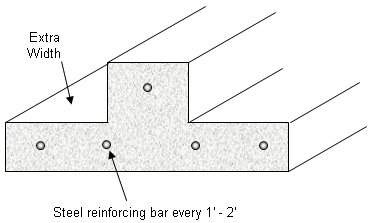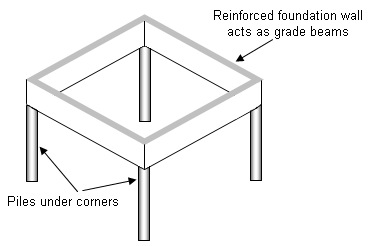Concrete Foundation Walls - Structural Deterioration And Damage
Problem: Cracks in foundations and slabs resulting from settlement and movement - 3.
Cause: Problem soils.
Problem soils commonly encountered in North America include peat and organic soils, soils in abandoned landfill sites, and clays - including normal, expansive and sensitive clays.
Solutions: Modify designs to suit the specific soil conditions.
- When encountering poor soil conditions, continue to excavate until you reach stable soils, or perform soil tests to determine foundation design requirements.
- Peat or organic soils will settle as moisture is squeezed out of the soils. Flexible service connections will be required. To minimize settlement problems;
- replace shallow peat deposits with compacted granular fill,
- use end-bearing or deep-friction piles,
- use raft foundations,
- use wider reinforced footings as shown in Figure 14.

Figure 14 - Peat Footing
- In normally consolidated clays use piles to prevent long-term settlement.
- Swelling or expansive clays will shrink or expand as they dry out or absorb water. To minimize problems, you can do the following;
- reinforce foundation walls to act as grade beams, and use piles to support walls, at corners, and teleposts as shown in Figure 15,

Figure 15 - Reinforced Foundation For Expansive Clay Soils
- employ a rigid foundation system consisting of reinforced walls and hollow-core floors to withstand differential settlement and twisting,
- Use a suspended wooden floor rather than a basement slab to avoid uplift pressures on the basement floor,
- backfill with a mixture of sand and bentonite (usually 20% by weight) to reduce soil pressures on basement walls and to prevent extreme fluctuations in the water content of the soil at the base of the foundations,
- Increase water content of the sub-grade prior to pouring the slab to prevent uplift pressures on the slab.
- Keep trees well away from the foundations to avoid changes in the water content of the surrounding soil.
- In sensitive clay soils, do not disturb the soils below the footings. The sub-grade must not be allowed to become wet or frozen. Pre-load the site to consolidate soils before beginning construction. The weight of the building should not be greater than the weight of the excavated, materials as shown in Figure 16.

Figure 16 - Building On Sensitive Clays
- In alkaline soils, use sulphate-resistant concrete.
- When constructing over landfill, extend footings or piles down to undisturbed soil. You will likely have to decide how to deal with methane gases in former garbage dumps. Movement of these gases into occupied spaces can pose a serious health risk to occupants.
